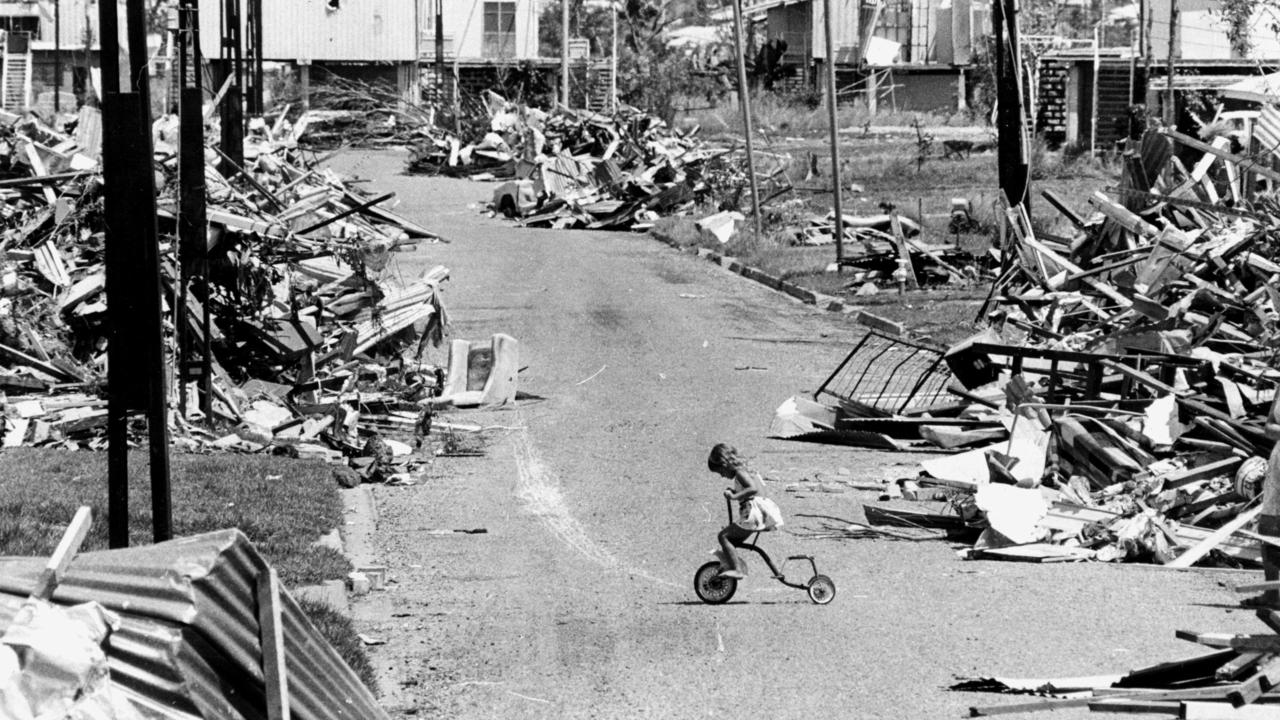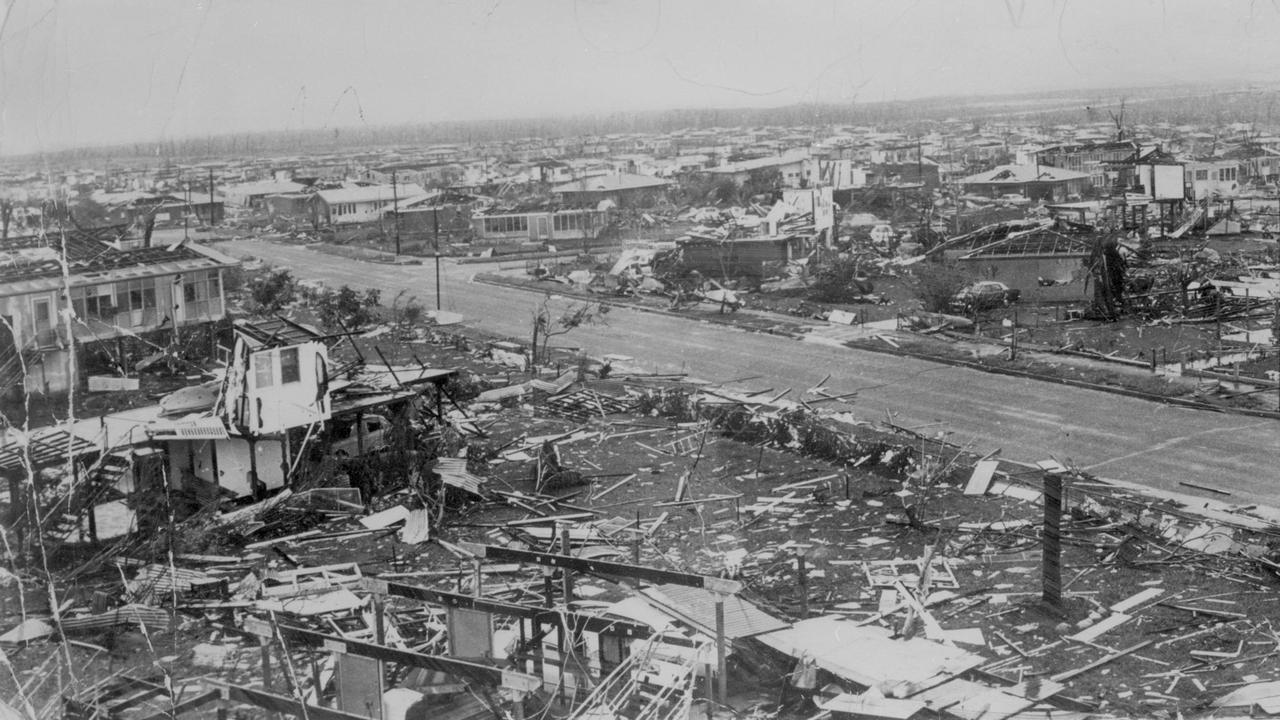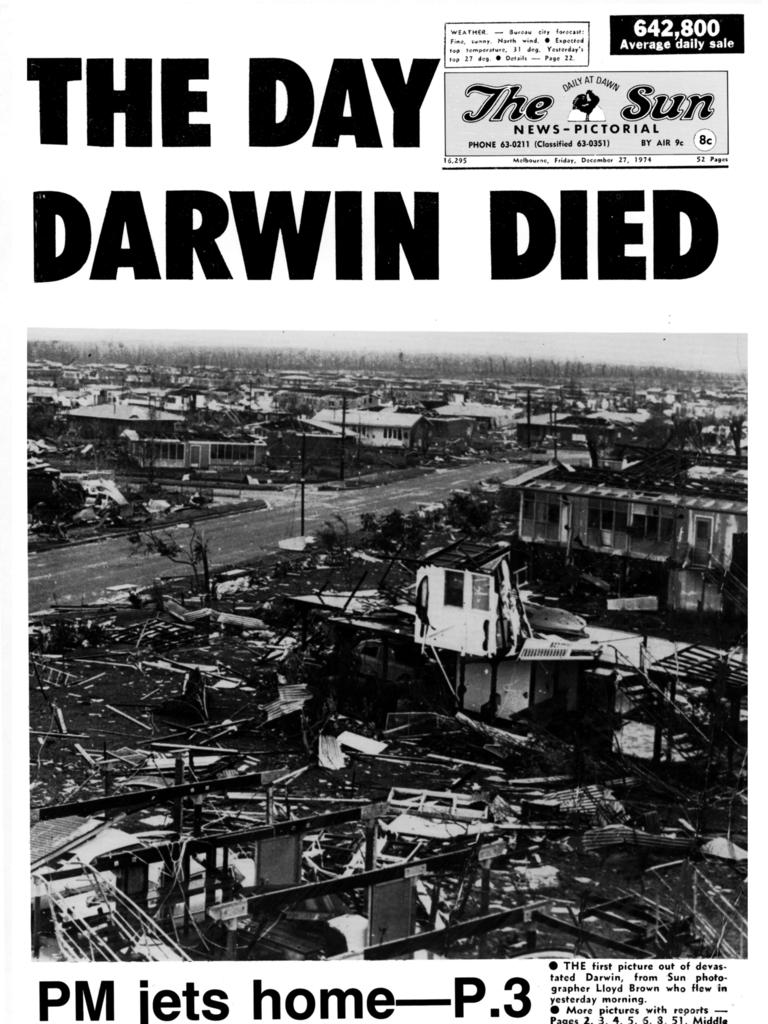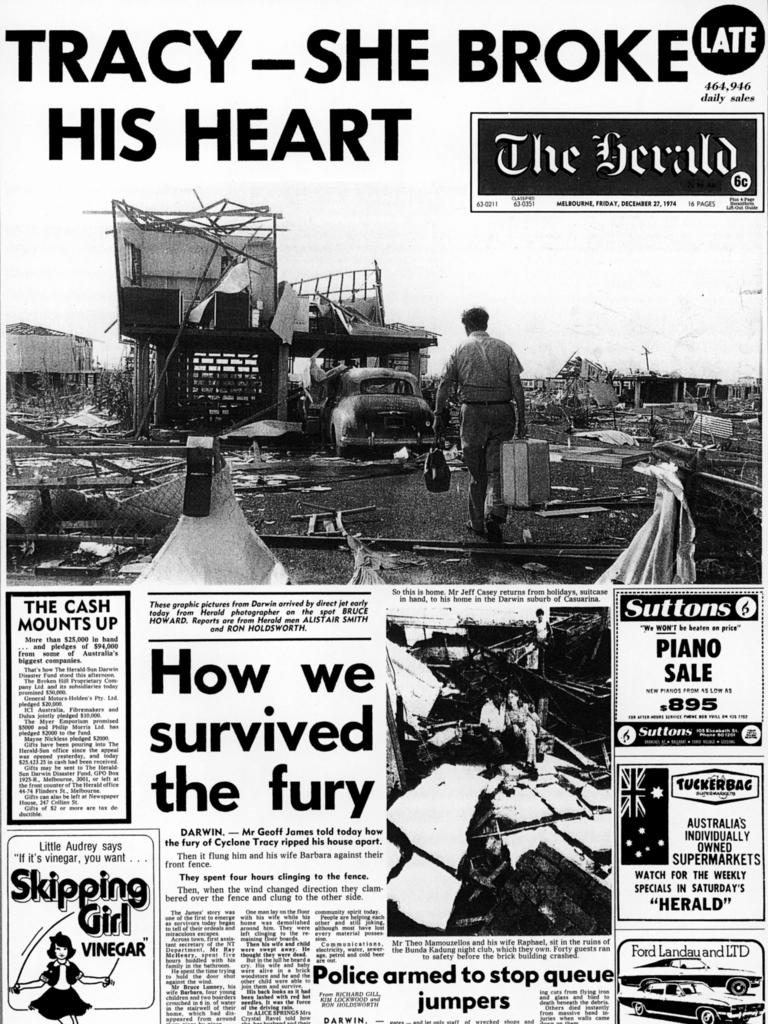Fifty years ago, Christmas Day delivered death and destruction to the 47,000 residents of Darwin.
The flattening of Darwin in the early hours of Christmas morning in 1974 was almost without historical precedent.
It was as though an atomic bomb had hit – and in fact many would later say Darwin resembled none other than Hiroshima or Nagasaki after Cyclone Tracy had finished with her.
Sixty-six died. Hundreds were injured. Four in five buildings had either been dismantled or seriously damaged.
About 36,000 evacuated. The damage bill topped $800m (about $7.7bn in 2023 dollars).
We still don’t know exactly how fast the winds whipped – they had reached 217km/h when the city’s anemometer gave out.
The losses felt especially cutting as this was not even the first time the Northern Territory capital had been reduced to rubble, courtesy of the Bombing of Darwin in 1942.
For a city to be razed once is unlucky. To be razed twice suggests something more akin to a curse.
Yet just three years later, thanks to a whole-of-government effort and the resilience of Territorians determined to defy nature and rebuild their lives, our home rose once again.
But while buildings could be, and were, rebuilt, much harder to fix were the mental scars: being a small town, everyone knew or knew of people who didn’t make it through the night.
Many evacuees elected not to return.
These days, a cyclone of Tracy’s ferocity would still devastate Darwin, but it would not decimate the city. Building standards have improved. Disaster response mechanisms are more sophisticated.

But we’ve seen it once before: December 25, 1974. Lightning could strike twice.
That the cyclone still looms large in the minds of Darwinites is clearly evidenced by the high passions felt between various parties over how the 50th anniversary of the disaster should be commemorated.
Five decades on, Cyclone Tracy continues to cast a long shadow on our tropical home.
Cyclone Tracy began forming as a tropical low on December 20, 1974, in the Arafura Sea, between Timor and West New Guinea, an area known as a ‘cyclone breeding ground’.
The system moved south and intensified and by December 21, satellite images showed it was becoming a tropical cyclone.
By the late evening of December 21, the Tropical Cyclone Warning Centre at Darwin had named the cyclone ‘Tracy’ - little did they know then how historic that name would later become.
At 10pm, with Cyclone Tracy 200km north-northeast of Cape Don, the TCWC issued its first warning to coastal communities between Goulburn Island and Bathurst Island.
By midnight, Tracy was moving sothwards and by 3am rounded Cape Fourcroy, on the southwest tip of Bathurst Island with winds of 120km/h.
As families prepared to celebrate Christmas on December 24, Tracy was gaining momentum and by midday, forecasters noted she had changed to a southeasterly course and was headed towards Darwin.
And so, a ‘top priority’ warning was issued at 12.30pm and widely broadcast: ‘‘Tracy is moving slowly closer to Darwin, very destructive winds of 120km/h with gusts at 150km/h are expected in the Darwin area tonight and tomorrow.’’
But as she drew closer, it appears Tracy grew stronger still - appearing to narrow and intensify the closer she got to Darwin.
At 1am on Christmas Day, Tracy struck the Northern Territory’s capital with full force; with wind speeds suspected to have peaked around 3am at velocities predicted to have been up to 250km/h.
Tracy’s centre appears to have crossed the Darwin coastline near Coconut Grove, before moving along the Darwin Airport runway and then switching southeast away from Darwin.
By lunchtime Christmas Day, when residents were just starting to pick up the pieces of their shattered lives, Tracy was near Fogg Day and denegrating into a rain depression.

Cyclone Tracy left in its wake a decimated Darwin that took years to recover and rebuild, and it of course left its scars, but it also shaped a new future for the Top End.
From cultural and societal shifts to more practical changes that have since become legal requirements in the Northern Territory, Darwin after Tracy would never be the same again.
While he wasn’t on the ground when the cyclone rolled in, Territory History curator Jared Archibald is a Territorian that began calling the Top End home after a ‘back to Darwin’ festival.
“They had back to Darwin air races, they had back to Darwin concerts, they had all these things trying to not just have people come back that we had before, but attract new people,” Mr Archibald said.
“This was the land of opportunity, Darwin was back on the map, there were places to live, it was a vibrant young go ahead, a place with huge opportunities, ‘come back or come’, they said.
“And that’s what my Dad did.”


At nine-years-old, Mr Archibald and his family moved to the Northern Territory in 1979 and he saw first hand the damage that was still left behind after Cyclone Tracy, but also how the Territory was emerging out of the rubble and into something new.
On July 1, 1978, the first NT self-government was established, which changed everything, Mr Archibald said.
“The way the commonwealth looked at us changed, the way [the Territory] was funded,” he said.
“But it also meant that Territorians had an actual say in what was happening, not just in Darwin but in the whole Northern Territory; and that changed everything.
“I got here in 1979 … and we were here for the first year anniversary.
“They gave out flags, they gave out pouches, you could tell it was this super proud place and we didn’t live there, we just walked into this but we were a part of this influx of new people coming.”
The transformation of Darwin in the wake of Cyclone Tracy was not only societal or political, but there were fundamental changes to how things were done.
A simple, albeit rather significant, change after Tracy was the shift from nailing down roofs to homes, to screwing them down, Charles Darwin University Associate Professor Steven Farram said.
“The biggest impact of all was the building code,” Mr Farram said.
“Pre Cyclone Tracy … there had been some criticism that the buildings that were being constructed at that time weren’t very robust.
“Not too much notice was taken about that.
“[Builders have] said all they ever did was just nail the roof down, that was it, just whack a nail in it.
“But when the wind comes in through a broken window, the pressure builds up in a house and it can just lift the roof off
“Post Cyclone Tracy, everything has to be screwed down, and that holds much better, it really made a difference.”
The rebuilding of Darwin mostly occurred in 1976 once the newly formed Darwin Reconstruction Commission had established new building codes – and most of the debris and damaged buildings were removed.
Mr Archibald said the navy, army and many others were a part of the big cleanup before the big rebuild.
“The rebuilding starts, the repair of repairable buildings and the building of complete new suburbs to rehouse,” he said.
“Within three years, the reconstruction commission had repaired or rebuilt around 3000 homes, at a huge cost.”

Mr Farram said the reason the rebuilding of Darwin cost so much was just how cyclone-resistant some of the new houses were.
“There are still some buildings around which were built post Cyclone Tracy in the earliest time, which really looked more like a fortress or a bomb shelter or something,” he said.
“They made them so strong, with narrow windows, very solid looking things.
“Whereas today they can build a house that doesn’t look so vastly different to houses like pre Cyclone Tracy, but they are.
“You don’t necessarily see straight away, but they are very, very strong and can withstand those cyclonic winds.”
By the 1990s, you couldn’t tell Darwin had been wiped out, Mr Archibald said.
When Cyclone Tracy struck Darwin, 66 people were killed. Of those who died, 45 were on land and 21 were at sea. These are their names and ages.
●Andrew Mark BRUHN (5 years)
●Arthur LIM (48 years)
●Avis Winifred DANIEL (29 years, died at sea on Mandorah Queen)
●Bolger WOTSANBUK (60 years)
●Catherine Michelle KNOX (5 months)
●Cecil Henry BONNER (75 years)
●Charles Joseph DIBUA (Adult,
unknown age)
●Cherry Leonie Rose STEPHENSON
(22 years)
●David Grant FEALY (19 years, died at sea on Flood Bird)
●Dean William BURGESS (2 years,
7 months)
●Dennis Keith HOLTEN (23 years, died at sea on Flood Bird)
●Donald James Duncan HOFF (36 years, died at sea on Kendall)
●Dorothy BLOOMFIELD (Adult, age unknown)
●Eileen Patricia May CLOUGH (31 years)
●Elva Dawn KNOX (29 years)
●Eric Arthur “Sandy” McNABB (74 years)
●Frederick Yee Char YU (36 years)
●Gary Roger FENTON (29 years)
●George ROEWER (21 years, died at sea on Flood Bird)
●George Valentine PARKER (32 years)
●Gerald Frederick THOMPSON (31 years, died at sea on MV Booya)
●Geraldine Elizabeth BROWN (8 years)
●Giovanni SMANIOTTO (70 years)
●Graham William DEARDEN (30 years, died at sea on MV Booya)
●Gregory John WESTERMAN (22 years, died at sea on MV Booya)
●Ian Robert RENNIE (Adult, age unknown, died at sea on HMAS Arrow)
●Jennifer Anne WOOD (37 years)
●John Dudley (Jack) LANG (Adult, unknown age)
●John TURNER (69 years)
●John Thomas TAYLOR (30 years)
●Kenneth James Scott WHEATLEY
(3 years, 11 months)
●Kerry Lynda WILLIAMS (21 months)
●Koji YOSHIDA (42 years, died at sea
on Kendall)
●Kylie Jane STEPHENSON (6 months)
●Leslie Kevin CATTON (33 years, died at sea on HMAS Arrow)
●Lisa Karoline HARDER (5 months)
●Louisa Fanny BUTLER (63 years)
●Malini Palathil BELL (40 years)
●Michael John GRANT (21 years, died at sea on Mandorah Queen)
●Michael John KNOX (30 years)
●Molly WILLIAMS (31 years)
●On’ing “Owen” LAY (29 years)
●Paul Alaister MACKLIN (36 years)
●Paul Mark CHANEY (7 months)
●Peter ANDREW (adult, age unknown)
●Peter Brian DAFFEY (6 years)
●Peter James DEWAR (32 years)
●Raymond Ian HAMPTON (35 years)
●Raymond John CURTAIN (28 years, died at sea on Darwin Princess)
●Richard Roland JAMES (24 years)
●Richard THOMPSON (85 years)
●Robert Gordon SWANN (19 years, died at sea on Flood Bird)
●Robert Norman WADE (20 years, died at sea on Frigate Bird)
●Ronald Charles MARSHALL (21 years, died at sea on Charles Todd)
●Rose Susanna CLARKE (74 years)
●Reuben Paul JAMES (22 days)
●Ruth Nazmeena Adrienne VINCENT
(24 years, died at sea on MV Booya)
●Shigemori ODOWARA (33 years, died at sea on Flood Bird)
●Shirley WENCK (Adult, unknown age)
●Siegfried Karl Otto WOLFE (30 years, died at sea on Mandorah Queen)
●Stephen James KNOX (3 years,
8 months)
●Suzanne Mary PORTMAN (8 years)
●Terrance Carew WESTWOOD (63 years, died at sea on MV Booya)
●Thomas William HANSON (70 years)
●William Daniel MUIR (60 years)
●William WOODYATT (34 years, died at sea on Frigate Bird)

Add your comment to this story
To join the conversation, please log in. Don't have an account? Register
Join the conversation, you are commenting as Logout
NT mums access life-changing rural mother’s group program
Territory mums living in remote areas are receiving the feedback and support they need through a revolutionary online mothers group program, which has just opened up scholarships.
You little cracker: Territory Day fireworks saved
Territory Day has been saved and Tuesday July 1 will be a cracker celebration after weeks of tense cross-border negotiations.